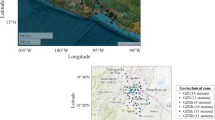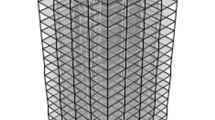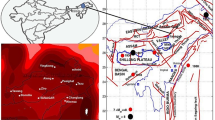Abstract
We argue that for critical structures near large earthquake sources: (1) the ergodic assumption, recent history, and simplified descriptions of the hazard are not appropriate to rely on for earthquake ground motion prediction and can lead to a mis-estimation of the hazard and risk to structures; (2) a physics-based approach can address these issues; (3) a physics-based source model must be provided to generate realistic phasing effects from finite rupture and model near-source ground motion correctly; (4) wave propagations and site response should be site specific; (5) a much wider search of possible sources of ground motion can be achieved computationally with a physics-based approach; (6) unless one utilizes a physics-based approach, the hazard and risk to structures has unknown uncertainties; (7) uncertainties can be reduced with a physics-based approach, but not with an ergodic approach; (8) computational power and computer codes have advanced to the point that risk to structures can be calculated directly from source and site-specific ground motions. Spanning the variability of potential ground motion in a predictive situation is especially difficult for near-source areas, but that is the distance at which the hazard is the greatest. The basis of a “physical-based” approach is ground-motion syntheses derived from physics and an understanding of the earthquake process. This is an overview paper and results from previous studies are used to make the case for these conclusions. Our premise is that 50 years of strong motion records is insufficient to capture all possible ranges of site and propagation path conditions, rupture processes, and spatial geometric relationships between source and site. Predicting future earthquake scenarios is necessary; models that have little or no physical basis but have been tested and adjusted to fit available observations can only “predict” what happened in the past, which should be considered description as opposed to prediction. We have developed a methodology for synthesizing physics-based broadband ground motion that incorporates the effects of realistic earthquake rupture along specific faults and the actual geology between the source and site.



















Similar content being viewed by others
References
Aagaard, B., Kientz, S., Knepley, M., Strand, L., & Williams, C. (2013). PyLith user manual, version 2.0.0. Davis, CA: Computational Infrastructure of Geodynamics.
Abrahamson, N. A., & Bolt, B. A. (1987). Array analysis and synthesis mapping of strong ground motion. In B.A. Bolt (Ed.), Strong Motion Synthetics (pp. 55–90). Orlando, Florida, U.S.A.: Academic Press.
Abrahamson, N. A., & Bommer, J. J. (2009). Sigma: Issues, insights, and challenges. Seismological Research Letters, 80, 41–56.
Aki, K., & Richards, P. G. (2002). Quantitative seismology (2nd ed.). University Science Books, ISBN: ISBN0935702962, 9780935702965, Sausalito, California, USA.
Anderson, J. G. (2004). A criterion for evaluating goodness of fit of accelerograms. In 13th World Conference on Earthquake Engineering, Vancouver, B.C., Canada, August 1–6, paper No. 243.
Anderson, J. G., & Brune, J. (2000). Probabilistic seismic hazard analysis without the ergodic assumption. Seismological Research Letters, 71, 19–28.
Andrews, D. J., Hanks, T. C., & Whitney, J. W. (2007). Physical limits on ground motion at Yucca Mountain. Bulletin of the Seismological Society of America, 97, 1771–1792.
Atkinson, G., & Macias, M. (2009). Predicted ground motions for great interface earthquakes in the Cascadia subduction zone. Bulletin of the Seismological Society of America, 99, 1552–1578.
Baker, J. W., & Cornell, C. A. (2004). Uncertainity propagation in probabilistic seismic loss estimation. Structural Safety, 30, 236–252.
Boatwright, J.L. (1981). Quasi-dynamic models of simple earthquake: an application to an aftershock of the 1975 Oroville, California earthquake. Bulletin of the Seismological Society of America, 71, 69–94.
Boatwright, J., Fletcher, J. B., & Fumal, T. E. (1991). A general inversion scheme for source, site, and propagation characteristics using multiply recorded sets of moderate-sized earthquakes. Bulletin of the Seismological Society of America, 81, 1754–1782.
Bommer, Julian J., & Abrahamson, Norman A. (2006). Why do modern probabilistic seismic-hazard analyses often lead to increased hazard estimates? Bulletin of the Seismological Society of America, 96, 1967–1977. doi:10.1785/0120060043. (Review Article).
Boore, David M., Joyner, William B., & Fumal, Thomas E. (1997). Equations for estimating horizontal response spectra and peak acceleration from Western North American earthquakes: A summary of recent work. Seismological Research Letters, 68, 128–153.
Campbell, K. W., & Bozorgnia, Y. (2003). Erratum: Updated near-source ground-motion (attenuation) relations for horizontal and vertical components of peak ground accelerations and aceleration response spectra. Bulletin of the Seismological Society of America, 93, 1413.
Conte, J. P., Pandit, H., Stewart, J. P., & Wallace, J. W. (2003). Ground motion intensity measures for performance-based earthquake engineering. In: Proceedings of the Ninth International Conference on Applications of Statistics and Probability in Civil Engineering (ICASP9), July 6–9. San Francisco, USA.
Cornell, C. A. (1968). Engineering seismic risk analysis. Bulletin of the Seismological Society of America, 58, 1583–1606.
Das, S., & Kostrov, B. V. (1990). Inversion for seismic slip rate history and distribution with stabilizing constraints: Application to the 1986 Andreanof islands earthquakes. Journal of Geophysical Research, 95, 6899–6913. doi:10.1029/90JB00701. (ISSN: 0148-0227).
Fenves, G. L., & Ellery, M. (1998). Behavior and failure analysis of a multiple-frame highway bridge in the 1994 Northridge Earthquake, Pacific Earthquake Engineering Research Center. Report No. PEER 98/08.
Fergany, E., & Hutchiings, L. (2017). Demonstration of pb-PSHA with Ras-Elhekma earthquake, Egypt. NRIAG Journal of Astronomy and Geophysics (in press, available online).
Foxall, B., Hutchings, L. J., & Kasameyer, P. W. (1996). Prediction of strong ground motion based upon physical constraints on fault rupture scenarios for ground motion prediction, Lawrence Livermore National Laboratory, UCRL-JC-11637.
Frankel, A. (1991). High-frequency spectral falloff of earthquakes, fractal dimension of complex rupture, b value, and the scaling of strength on faults. Journal of Geophysical Research, 96, 6291–6302.
Fugro-Earth Mechanics. (2001). Caltrans Seismic Advisory Board.
Gap Workshop Report. (2012). “Nuclear energy advancing modeling and systems campaign (NEAMS)”; conveners: James A. Blink (Lawrence Livermore National Laboratory) and Robert J. Budnitz (Lawrence Berkeley National Laboratory), March 15, 2012.
Golara, A., & Ahmady Jazany, R. (2013). An improvement on the use of empirical green functions for ground motion synthesis to predict Tehran’s main earthquake. Scientific Research and Essays, 8(19), 731–753.
Golara, A., & Hamzehloo, H. (2006). Strong ground motion modeling for the 2004 Firozabad–Kojoor Earthquake, North of Iran. First European Conference on Earthquake Engineering and Seismology (a joint event of the 13th ECEE and 30th General Assembly of the ESC) Geneva, Switzerland, 3–8 September. Paper Number: 895.
Graves, R. W., & Pitarka, A. (2010). Broadband ground-motion simulation using a hybrid approach. Bulletin of the Seismological Society of America, 100, 2095–2123.
Guatteri, M. P., Mai, M., Beroza, G. C., & Boatwright, J. (2003). Strong ground-motion prediction from stochastic-dynamic source models. Bulletin of the Seismological Society of America, 93, 301–313.
Guo-Quan, W., Zhou, X.-Y., Ma, Z.-J., & Zhang, P.-Z. (2001) A preliminary study on the randomness of response spectra of the 1999 Chi-Chi, Taiwan, earthquake. Bulletin of the Seismological Society of America, 91, 1388–1389.
Hartzell, S. H. (1978). Earthquake aftershocks as Green’s functions. Geophysical Research Letters, 5(1):1–4
Hartzell, S., Harmsen, S., Frankel, A. & Larsen, S. (1999). Calculation of broadband time histories of ground motion: comparison of methods and validation using strong-ground motion from the 1994 Northridge earthquake. Bulletin of the Seismological Society of America, 89, 1484–1504.
Heuze, F. E., Ueng, T. S., Hutchings, L. J., Jarpe, S. P., & Kasameyer, P. W. (1997). A coupled seismic-geotechnical approach to site-specific strong motion. Soil Dynamic and Earthquake Engineering, 16(4), 259–272.
Hutchings, L. (1991). ‘Prediction’ of strong ground motion for the 1989 Loma Prieta earthquake using empirical Green’s functions. Bulletin of the Seismological Society of America, 81, 88–121.
Hutchings, L. (1994). Kinematic earthquake models and synthesized ground motion using empirical Green’s functions. Bulletin of the Seismological Society of America, 84, 1028–1050.
Hutchings, L., & Viegas G. (2012). Application of Empirical green’s functions in earthquake source, wave propagation and strong ground motion studies. Earthquake Research and Analysis, New Frontiers in Seismology, chapter 3, 87-140. Edited by Sebastiano D’Amico, InTech Publishing, on-line link: http://www.intechopen.com/search?q=New+Frontiers+in+Seismology.
Hutchings, L., Foxall, B., Kasameyer, P., Larsen, S., Hayek, C., Tyler-Turpin, C., Aquilino, J., & Long, L. (2005). Deep borehole instrumentation along San Francisco bay bridges: 1996–2003 and strong ground motion synthesis along the San Francisco/Oakland Bay Bridge. Final Report, Lawrence Livermore National Laboratory, Livermore, CA, UCRL-TR-2117303.
Hutchings, L., Ioannidou, E., Jarpe, S., & Stavrakakis, G. N. (1997). Strong ground motion synthesis for a M = 7.2 earthquake in the Gulf of Corinth, Greece using empirical Green’s functions. Lawrence Livermore National Laboratory, Livermore, CA, UCRL-JC-129394.
Hutchings, Lawrence, Ioannidou, Eleni, Kalogeras, Ioannis, Voulgaris, Nicholas, Savy, Jean, Foxall, William, et al. (2007). A physically based strong ground-motion prediction methodology; Application to PSHA and the 1999 M=6.0 Athens Earthquake. Geophysical Journal International, 168, 569–680.
Hutchings, L., & Jarpe, S. (1996). Ground-motion variability at the highway 14 and I-5 interchange in the Northern San Fernando valley. Bulletin of the Seismological Society of America, 86, S289–S299.
Hutchings, L., Jarpe, S., & Kasameyer, P. (1998). Validation of a ground motion synthesis and prediction methodology for the 1988, M = 6.0, Saguenay Earthquake. Lawrence Livermore National Laboratory, Livermore, CA, UCRL-JC-129395.
Hutchings, L. J., Jarpe, S. P., Kasameyer, P. W., & Foxall, W. (1996). Synthetic strong ground motions for engineering design utilizing empirical Green’s functions. Presented at Eleventh World Conference of Earthquake Engineering, Acapulco, June 23–28, 1996 (CDROM Elsevier); available from Lawrence Livermore National Laboratory, Livermore, CA, UCRL-JC-123762.
Hutchings, L., Kasameyer, P. W., & Foxall, W. (2003). LLNL (p. 135697). Lawrence Livermore National Laboratory, Livermore, CA, UCRL-ID: Hazard mitigation center ground motion prediction methodology.
Hutchings, L., & Wu, F. (1990). Emprical green’s functions from small earthquakes: A waveform study of locally recorded aftershocks of the 1971 San Fernando earthquake. Journal of Geophysical Research, 95, 1187–1214.
IAEA. (2007). IAEA Issues report on Kashiwazaki–Kariwa nuclear plant. https://www.iaea.org/newscenter/news/iaea-issues-report-kashiwazaki-kariwa-nuclear-plant.
IAEA. (2014). Nuclear power plants and earthquakes. http://www.world-nuclear.org/information-library/hsafety-and-security/safety-of-plants/nuclear-power-plants-and-earthquakes.aspx.
Ioannidou, E., Voulgaris, N., Kalogeras, N., Hutchings, I., & Stavrakakis, G. (2001). Analysis of site response in the Athens area from the 7 September 1999, Mw = 5.9 Athens earthquake and aftershock recordings, and intensity observations. Bollettino di Geofisica Teorica ed Applicata, Special Issue on Site Response, December 2001.
Irikura, K. (1986). Prediction of strong acceleration motion using empirical Green’s function. Proc. 7th Japan Earthq. Eng. Synp. 151-156.
Jarpe, S., & Kasameyer, P. K. (1996). Validation of a methodology for predicting broadband strong motion time histories using kinematic rupture models and empirical Green’s functions. Bulletin of the Seismological Society of America, 86, 1116–1129.
Joyner, W. B., & Boore, D. M. (1986). On simulating large earthquakes by green’s-function addition of smaller earthquakes. In S. Das, J. Boatwright, & C. H. Scholz (Eds.) Earthquake Source Mechanics, Geophysical Monograph 37 Maurice Ewing, vol. 6 (pp. 269-274). Washington, DC, USA: American Geophysical Union.
Kiratzi, A., Karakaisis, G., Papadimitriou, E., & Papazachos, B. (1985). Seismic source-parameter relations for earthquakes in Greece. Pure and Applied Geophysics, 123, 27–41.
Larsen, S., & Schultz, C. A. (1995). ELAS3D: 2D/3D elastic finite-difference wave propagation code, Technical Report UCRL-MA-121792. Livermore: Lawrence Livermore National Laboratory.
Liu, P., Custódio, S., & Archuleta, R. J. (2006). Kinematic inversion of the 2004 Mw6.0 Parkfield earthquake including site effects. Bulletin of the Seismological Society of America, 96, S143–S158.
Makris, J., Papoulia, J., & Drakatos, G. (2004a). Tectonic deformation and microseismicity of the Saronikos Gulf, Central Greece. Bulletin of the Seismological Society of America, 94, 920–929.
Makris, J., Papoulia, J., Ilinski, D., & Karastathis, V. (2004a). Crustal study of the Saronikos–Corinthiakos basins from wide aperture seismic data: Intense crustal thinning below the Saronikos Basin. 10th Conference of the Hellenic Geological Society, Thessaloniki, Greece (Abstract).
McCallen, D. B., & Hutchings, L. J. (1996). Ground motion estimation and nonlinear seismic analysis. LLNL, UCRL-JC-121667. In: Proceedings of the 12th Conference on Analysis and Computation of the American Society of Civil Engineers. Chicago, Illinois.
McCallen, D., Astaneh-Asl, A., Larsen, S., & Hutchings, L. (2006). Dynamic response of the suspension spans of the San Francisco-Oaklnad Bay Bridge. Proceedings of the 8th US National Conference on Earthquake Engineering April 18-22, San Francisco, California, USA, Paper No. 952.
McCallen, D. B., Astaneh-Asl, A., Larsen, S. C. (2015). Near-field earthquake ground motions and the response of building structures. Report no 2273, global security computing applications division (p. 57). Lawrence Livermore National Laboratory, Livermore, CA.
Mert A., Fahjan, Y., & Hutchings, L. (2010). Prens adaları fayındaki depremlerin kaynak parametrelerinin eş zamanlı ve tekil ters çözüm teknikleri ile belirlenmesi. İstanbul Yerbilimleri Dergisi, C.23, S.1, SS. 53,63.
Mert, A., Fahjan, Y., Pinar A., & Hutchings, L. (2014). Earthquake simulation studies for the Marmara region using empirical Green’s functions method (submitted).
Mert, A., Fahjan, Y., Pınar, A., & Hutchings, L. (2011). İstanbul için tasarım esaslı kuvvetli yer hareketi dalga formlarının zaman ortamında türetilmesi. 1. Türkiye Deprem Mühendisliği ve Sismoloji Konferansı, ODTÜ, Ankara. http://search.mymapsxp.com/?uid=f21c2878-56f54c1a96ca49ded5451765&uc=20150713&source=pd_gs_g_map_mapquest_directions&page=homepage&implementation_id=Maps_xp_0.0.2L .
Mert, A., Fahjan, Y., Pınar, A., & Hutchings, L. (2012). EGF simulation of high frequency ground motion. A case study for Mw = 5.0 Central Marmara Fault Earthquake, 15 WCEE, Lisbon.
Miah, M. (2016). Development of a dynamic coupled hydro-geomechanical code and its application to induced seismicity. Dissertation, Department of Civil Engineering, The University of Mississippi.
NISA. (2008). KashiwZAKI-kARIWA Nuclear Power Station, Tokoyo Electric Power Company. Interim Report on the Geology and Geological Structure of the Ground Surrounding the Site and on the Evaluation of the Design Basis Ground Motion, Nuclear and Industrial Safety Agency, November 18.
Orowan, E. (1960). Mechanism of seismic faulting. Geological Society of America Bulletin, 79, 323–345.
Papanikolaou, D., Lykousis, V., Chronis, G., & Pavlakis, P. (1988). A comparative study of Neotectonic basins along the Hellenic Arc: The Messiniakos, Argolikos, Saronikos and Southern Evoikos Gulf. Basin Research, 1, 167–176.
Papoulia, J., Fahjan, Y.M., Hutchings, L., & Novikova, T. (2015). PSHA for broad-band strong ground-motion hazards in the Saronikos Gulf, Greece, from potential earthquake with synthetic ground motions. Journal of Earthquake Engineering, 624–648. doi:10.1080/13632469.2014.991977.
Pavic, R., Koller, M. G., Bard, P.-Y., & Lacave-Lachet, C. (2000). Ground Motion prediction with the empirical Green’s function technique: an assessment of uncertainties and confidence level. Journal of Seismology, 4, 59–77.
Porter, K. A. (2003). An overview of PEER’s performance-based earthquake engineering methodology. Department of Civil Engineering, California Institute of Technology, Pasadena, CA.
Schulz, C. H. (2002). The mechanics of earthquakes and faulting (p. 471). Cambridge: Cambridge University Press.
Scognamiglio, Laura, & Hutchings, Lawerence. (2009). A test of a physically-based strong ground motion prediction methodology with the 27 September 1997, Mw = 6.0 Colfiorito Earthquake (Umbria-Marcha Sequence), Italy Earthquake. Tectonophysics, 476, 145–158.
Senior Seismic Hazard Analysis Committee (SSHAC), Budnitz, R. J., Apostolakis, G., Boore, D. M., Cluff, L. S., Coppersmith, IC J., Cornell, C. A., & Morris, P. A. (1997). Recommendations for probabilistic seismic hazard analysis: guidance on uncertainty and use of experts. NUREG/CR-6372, Lawrence Livermore National Laboratory, UCRL-ID-122160. V1.
Somerville, P. G., Sen, M., & Cohee, B. (1991). Simulation of strong ground motion recorded during the 1985 Michoacan Mexico and Valparaiso, Chile earthquakes. Bulletin of the Seismological Society of America, 81, 1–28.
Somerville, P., Irikura, K., Graves, R., Sawada, S., Wald, D., Abrahamson, N., et al. (1999). Characterizing crustal earthquake slip models for the prediction of strong ground motion. Seismological Research Letters, 70, 59–80.
Stepp, J. S., & Wong, I. G. (2003). Probabilistic seismic hazard analysis for Yucca Mountain. In Presentation to the Nuclear Waste Technical Review Board, February 24, 2003.
Strasser, F. O., Abrahamson, N. A., & Bommer J. J. (2009). Sigma: Issues, insights, and challenges. Seismological Research Letters, 80.
Tse, S. T., & Rice, J. R. (1986). Crustal earthquake instability in relation to the depth variation of frictional slip properties. Journal of Geophysical Research, 91, 9452–9472.
Tullis, T. E., Richards, K., Barall, M., Dieterich, J. H., Field, E. H., Hein, E. M., et al. (2012). Comparrison among observations and earthquake simulator results for the allcal2 california fault model. Bulletin of the Seismological Society of America, 83, 994–1006.
Tumarkin, A. (1994). Energy constraints on synthesis of strong ground motion, Abs. American Geophysical Union, San Francisco, 4, 59–77.
Uetake, T., Nishimura, I., & Mizutani, H. (2008). Characteristics of strong motion records in Kashiwazaki–Kariwa nuclear power station during the Niigataken Chuetsu–Oki earthquake in 2007. The 14 World Conference on Earthquake Engineering October 12–17, 2008, Beijing, China.
USNRC. (1980). Reconnaissance report: Effects of November 8, 1980 earthquake on Humboldt Bsy Power Plant and Eureka. California area, U.S. Nuclear Regulatory Commission (pp. 1–8).
Wang, S. (2006). Understanding seismic hazard and risk assessments: an example in the new madrid seismic zone of the central United States. Proceedings of the 8th U.S. National Conference on Earthquake Engineering April 18–22, 2006, San Francisco, California, USA, Paper No. 416.
Wells, D. L., & Coppersmith, K. J. (1994). New empirical relationships among magnitude, rupture length, rupture width, rupture area, and surface displacement. Bulletin of the Seismological Society of America, 84, 974–1002.
Wollen, E., Seth, S., Pazzaglia, F., Meltzer, A., Kafka, A., & Berti, C. (2012). Mineral, Virginia, earthquake illustrates seismicity of a passive-aggressive margin. Geoph Res Lett, 39, 2.
Wossner, J., Treml, M., & Wenzel, F. (2002). Simulation of Mw = 6.0 earthquakes in the Upper Rhinegraben using Empirical Green functions. Geophysical Journal International, 151, 487–500.
Wu, F. T. (1978). Prediction of strong ground motion using small earthquakes. Proceedings of 2nd International Conference on Microzonation National Science Foundation, San Francisco, CA, pp. 701–704.
Acknowledgements
We benefited from technical editing by Mariel Nelson. Research was funded independently by the institutions listed as the authors’ address.
Author information
Authors and Affiliations
Corresponding author
Rights and permissions
About this article
Cite this article
Hutchings, L., Mert, A., Fahjan, Y. et al. Physics-Based Hazard Assessment for Critical Structures Near Large Earthquake Sources. Pure Appl. Geophys. 174, 3635–3662 (2017). https://doi.org/10.1007/s00024-017-1572-4
Received:
Revised:
Accepted:
Published:
Issue Date:
DOI: https://doi.org/10.1007/s00024-017-1572-4




